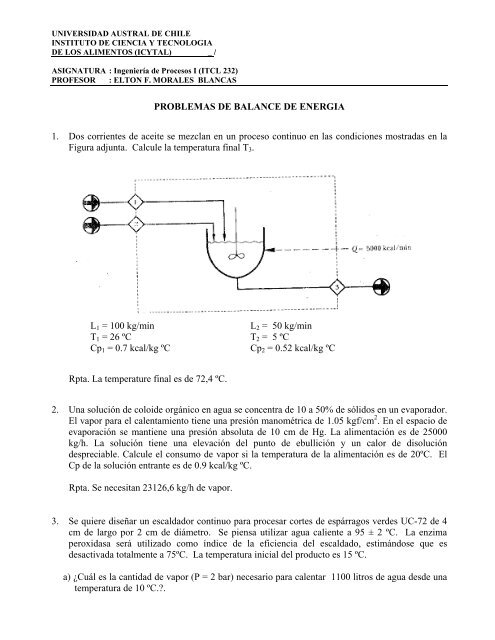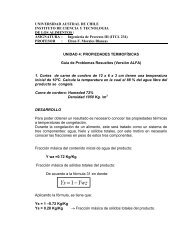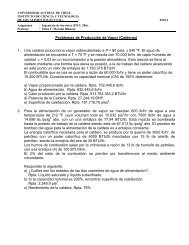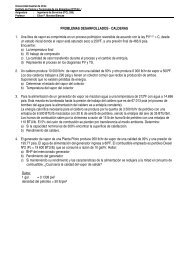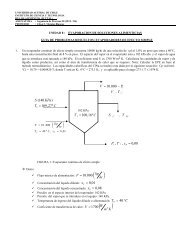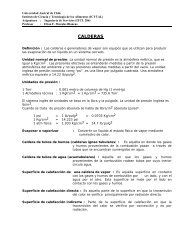Guía de Problemas - Balance Energía 2.pdf - ICYTAL - UACh ...
Guía de Problemas - Balance Energía 2.pdf - ICYTAL - UACh ...
Guía de Problemas - Balance Energía 2.pdf - ICYTAL - UACh ...
You also want an ePaper? Increase the reach of your titles
YUMPU automatically turns print PDFs into web optimized ePapers that Google loves.
UNIVERSIDAD AUSTRAL DE CHILE<br />
INSTITUTO DE CIENCIA Y TECNOLOGIA<br />
DE LOS ALIMENTOS (<strong>ICYTAL</strong>) _ /<br />
ASIGNATURA : Ingeniería <strong>de</strong> Procesos I (ITCL 232)<br />
PROFESOR : ELTON F. MORALES BLANCAS<br />
PROBLEMAS DE BALANCE DE ENERGIA<br />
1. Dos corrientes <strong>de</strong> aceite se mezclan en un proceso continuo en las condiciones mostradas en la<br />
Figura adjunta. Calcule la temperatura final T3.<br />
L1 = 100 kg/min<br />
T1 = 26 ºC<br />
Cp1 = 0.7 kcal/kg ºC<br />
Rpta. La temperature final es <strong>de</strong> 72,4 ºC.<br />
L2 = 50 kg/min<br />
T2 = 5 ºC<br />
Cp2 = 0.52 kcal/kg ºC<br />
2. Una solución <strong>de</strong> coloi<strong>de</strong> orgánico en agua se concentra <strong>de</strong> 10 a 50% <strong>de</strong> sólidos en un evaporador.<br />
El vapor para el calentamiento tiene una presión manométrica <strong>de</strong> 1.05 kgf/cm 2 . En el espacio <strong>de</strong><br />
evaporación se mantiene una presión absoluta <strong>de</strong> 10 cm <strong>de</strong> Hg. La alimentación es <strong>de</strong> 25000<br />
kg/h. La solución tiene una elevación <strong>de</strong>l punto <strong>de</strong> ebullición y un calor <strong>de</strong> disolución<br />
<strong>de</strong>spreciable. Calcule el consumo <strong>de</strong> vapor si la temperatura <strong>de</strong> la alimentación es <strong>de</strong> 20ºC. El<br />
Cp <strong>de</strong> la solución entrante es <strong>de</strong> 0.9 kcal/kg ºC.<br />
Rpta. Se necesitan 23126,6 kg/h <strong>de</strong> vapor.<br />
3. Se quiere diseñar un escaldador continuo para procesar cortes <strong>de</strong> espárragos ver<strong>de</strong>s UC-72 <strong>de</strong> 4<br />
cm <strong>de</strong> largo por 2 cm <strong>de</strong> diámetro. Se piensa utilizar agua caliente a 95 ± 2 ºC. La enzima<br />
peroxidasa será utilizado como índice <strong>de</strong> la eficiencia <strong>de</strong>l escaldado, estimándose que es<br />
<strong>de</strong>sactivada totalmente a 75ºC. La temperatura inicial <strong>de</strong>l producto es 15 ºC.<br />
a) ¿Cuál es la cantidad <strong>de</strong> vapor (P = 2 bar) necesario para calentar 1100 litros <strong>de</strong> agua <strong>de</strong>s<strong>de</strong> una<br />
temperatura <strong>de</strong> 10 ºC.?.
) ¿Cuál sería la cantidad <strong>de</strong> vapor necesario para procesar 1500 kg/hr <strong>de</strong> cortes <strong>de</strong> espárragos?.<br />
Nota: En ambos casos consi<strong>de</strong>rar <strong>de</strong>spreciable la pérdida <strong>de</strong> energía.<br />
4. Para concentrar el jugo <strong>de</strong> naranjas se parte <strong>de</strong> un extracto que contiene 12,5% <strong>de</strong> sólidos y está a<br />
20ºC. El jugo fresco se pasa a los evaporadores al vacío y parte se <strong>de</strong>riva para luego diluir el<br />
jugo concentrado que sale <strong>de</strong>l evaporador con 58% <strong>de</strong> sólidos hasta la concentración final <strong>de</strong>l<br />
42% sólidos.<br />
Si se tratan 2000 kg/h <strong>de</strong> jugo diluido y el vapor que se emplea para evaporar es <strong>de</strong> 20 psig,<br />
encuentre el vapor necesario para esta operación. La presión barométrica es <strong>de</strong> 586 mmHg y la<br />
<strong>de</strong> vacío <strong>de</strong>ntro <strong>de</strong>l evaporador <strong>de</strong> 466 mm Hg. El Cp <strong>de</strong> las disoluciones se consi<strong>de</strong>ra como 1,0<br />
kcal/kg ºC.<br />
Rpta. Se requieren 1635,39 kcal/h <strong>de</strong> vapor


